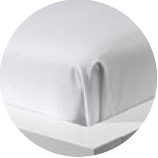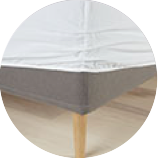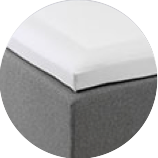
Planting the Supima cotton seeds
The production process starts out on a Supima cotton farm in California where seeds are planted in March and April. Supima is derived from Superior Pima.Cotton grows best on fertile, well-drained soils that have a good water holding capacity. Supima’s family of cotton growers are in the vanguard of innovation using and developing some of the most technologically advanced agricultural processes available. The farming practices employed set environmental and ethical standards for cotton around the world.

Water management in the cotton fields
Cotton is often (somewhat inaccurately) criticized for being a high user of water, however, in fact cotton uses much less water than most other crops grown in the area (Source: Foley, 1993). As an example Almonds are grown on a roughly five times larger area in California and require about 50% more water. Don’t get us wrong, the water usage of cotton is still high, but if California actually shifted more of its agriculture towards cotton, less water would be used. In order to minimize water usage, Supima cotton fields are laser-leveled. Based on the topography and specific make-up of the soil, farmers select the optimal method for irrigating the crop; either through drip irrigation, which directly feeds the plant only, or flood irrigation to restore moisture to the soil, which has the added benefits of replenishing aquifers, promoting soil health, and even fostering wildlife.
Harvesting the cotton

The Supima zero waste model
By weight, cotton fiber represents approximately 35% of the plant that is picked. All plant materials such as stalks, stems, seeds, and leaves are captured during the ginning process and are utilized locally as much-needed bedding for livestock. By law, all fields must be cleared of plant material at the end of the harvest to prevent the persistence of pests into the next season. One of the most valuable products of the seed is cottonseed oil. It’s considered a premium oil because it is flavorless, odorless, and has a high flashpoint.
Soil conservation among Supima farmers
Supima is grown on approximately 500 family-owned farms, many of which are passed down from generation to generation. Their land is their legacy and great care is taken to preserve the health of the soil. Except for minimizing the use of pesticides farm stewardship practices includes the regular rotation of crops to optimize the health of the soil. Annual rotations help to keep soil nutrient levels in balance and vary by area. Advanced technologies are utilized such as GPS-guided tractors that keep the wheels on the same path as prior passes. This minimizes the need for tilling the soil while maximizing seed germination and crop yields.

Spinning to create a yarn
The cotton is then packed up and shipped off to Pakistan. We don’t have full insight into this step of our value chain and the vendor for this service might change from time to time. Most commonly the cotton is shipped in 40-foot containers that contain about 20 tons of baled cotton. While transport instinctively feels like a big part of CO2 emissions, it is actually only a fraction of CO2 emission during the production of fabric goods.
In Pakistan, we are working with a state-of-the-art spinning mill. The mill is run on solar panels and even overproduces energy through that they sell to other factories in the area. They e.g. use equipment from Truetzschler (Germany), Toyota (Japan), and Reiter (Switzerland) in the production process.
Spinning in itself is the twisting technique where the fiber is drawn out, twisted, and wound onto a bobbin (essentially a cylinder).
The mill holds a range of certifications, among them Supima certification, which is required to be part of the Supima cotton value chain and GOTS certification. But most important of all they have a responsible mindset, they are currently investing in reducing their water usage.

Creating the weave
The bobbins are transported to Portugal where the fabric is woven and dyed in 1005 organically dyed with its final color. . The fabric is created by spinning fine yarns and creating a luxurious sateen weave.
Finishing
Finally, products are finished and sewn to perfection by textile artisans at the factory.
The labels are also produced in Portugal. As are the biodegradable bags that the sheets arrive in. The bag is made of 100% biodegradable plastic-substitute that leaves zero microplastics behind when it has degraded. Authentic mother of pearl buttons is sewn onto the duvet covers.
Finally, before leaving the factory, all products are washed, folded, and packed to give you that amazing crisp feeling when you first open your Juniper bedding.
Picking, packing and sending it off to you
The bed linen are then transported by truck to the boarders of Stockholm in Sweden where we have our logistics partner. Amazing personell then takes over and pack all the boxes with the goods.
If you have any more questions or feedback, don’t hesitate to reach out to care@jun-per.com, and we’ll answer as quickly as we can.

Wash & Care
We spend about one-third of our lives in bed, hence it is important to regularly wash your bed linens so they stay fresh.
– Wash every two weeks
– Wash separately from other laundry and ensure there is sufficient room in the machine
– Wash at 40-60° Celsius at centrifuge ~1000 rpm
– Tumble dry if you want a soft feeling to your sheets
– Hang to dry while still at least a little bit wet to decrease wrinkles
– Iron or mangle to get that hotel feeling


